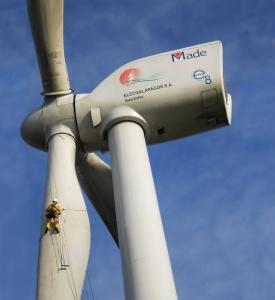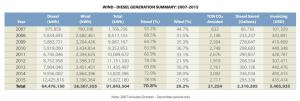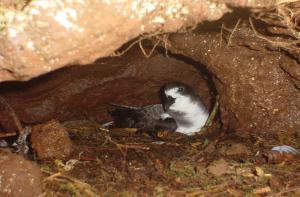Wind turbines on Galapagos replace millions of liters of diesel since 2007, meet 30 percent of energy needs

A performance summary and recommendations for the expansion of renewable energy on the Galapagos are contained in a new report by the Global Sustainable Electricity Partnership (GSEP, formerly the e8), a not-for-profit association of 11 of the world's for
World's top utilities hand over project keys, chart renewable energy path to meet fast-rising energy needs of Ecuador's famously biodiverse archipelago
Now, after eight successful years, the project's new operators are pursuing an ambitious expansion that would multiply the benefits of renewable energy for this remote, precious archipelago with a growing appetite for electricity.
A performance summary and recommendations for the expansion are contained in a new report by the Global Sustainable Electricity Partnership (GSEP), a not-for-profit association of 11 of the world's foremost electricity firms, which led and financed the $10 million project.
The project's three 51-metre-tall wind turbines and two sets of solar panels have supplied, on average, 30% of the electricity consumed on San Cristóbal, the archipelago's second-largest island in size and population, since it went into operation in October 2007.
During that time, it has displaced 8.7 million litres (2.3 million gallons) of diesel fuel and avoided 21,000 tonnes of carbon dioxide emissions, the GSEP report states. The achievements have led to awards from Power Engineering Magazine, World Energy Forum, and Energy Globe.
The proposed expansion could boost the renewable energy share to 70 per cent, en route to a hoped-for elimination of fossil fuels, the report states. It could also be a template for energy development elsewhere in the Galapagos chain -- where renewable sources now account for 20% of electricity production -- and elsewhere around the world.
Although most islands are uninhabited and protected from development, a few have growing populations, now 30,000 in all (up from 25,000 in 2010, with 33,000 forecast by 2020), economically supported by thriving tourism, which is capped at 200,000 annual visitors.
San Cristóbal, site of the provincial capital, is among the busiest islands with a bustling port and airport.
Each of the three turbines, designed to operate at a very low wind speed, has a capacity of 800 kilowatts. Over the first eight years, they have functioned a remarkable 92% of the time, and produced more than 26 million kilowatt-hours of electricity.
The project also includes two six-kilowatt solar installations that have generated 136,000 kilowatt-hours of electricity, as well as new transmission lines and advanced control systems that let the renewable and diesel components work together efficiently.
The project also boasts several environmental successes.
Its license requires it to follow an Environmental Management Plan, a set of measures to protect unique bird populations, in particular the Galapagos petrel, which exists only on the archipelago and is listed as "critically endangered" by the International Union for Conservation of Nature (IUCN).
No petrels are known to have been injured during the eight years of wind turbine operations and nest monitoring reveals the pest controls are working. From 2012 to 2014, hatching success rates increased from 85 to 96%, reproductive success grew from 81 to 100%, and the petrel population appears to be growing.
ELECGALÁPAGOS forecasts that, despite energy-conservation programs, electricity demand will rise by 60% from now to 2024, on top of a 275% increase realized since 2003. Consumption is spurred by the rising population, a new hospital and hotel, and other factors. A national attempt to reduce the use of fossil fuels through a shift from ovens fuelled by liquefied petroleum gas to electric induction models will add about 1.3 megawatts to annual demand on San Cristóbal.
The report concludes that, with respect to energy on San Cristóbal, "a renewable penetration rate of at least 70 per cent may be achieved within a reasonable investment range." And it offers a four-step plan:
* Overhaul and fully automate the controls that mesh diesel and wind generation
* Install more solar photovoltaic capacity
* Add a fourth wind turbine unit at the existing wind park at El Tropezón hill
* Install batteries to store electricity generated when winds are strong for dispatch when they are low. The project currently has no storage.
GSEP has agreed to fund an evaluation, led by German utility RWE, of a phase 2 expansion of the project involving the organization. RWE will assess the feasibility of options to further increase the share of renewables on San Cristobal and to deploy innovative energy solutions such as advanced integrated technology portfolios consisting of wind, solar PV and battery storage.
Previous reports (2007 and 2013): http://www.globalelectricity.org/galapagos
Global Sustainable Electricity Partnership
Based in Montreal, the Global Sustainable Electricity Partnership is a non-profit organization playing an active role on international global electricity issues and promoting sustainable energy development through electricity projects and human capacity building activities in developing and emerging nations worldwide.
With a combined total of 1.2 billion customers, the 11 GSEP utilities -- American Electric Power (USA), Électricité de France (France), Eletrobras (Brazil), ENEL (Italy), EuroSibEnergo (Russia), Hydro-Québec (Canada), Iberdrola (Spain), Kansai Electric Power Company (Japan), RusHydro (Russia), RWE (Germany) and State Grid Corporation of China -- delivered about one third of the world's electricity last year, of which approximately 60% was generated with no direct CO2 emissions -- from hydro, other renewables and nuclear.
The group has 2 .4 million employees, 4,000 of them dedicated to research and development, and invests roughly $3 billion in R&D each year.
* * * * *
News release in full:
http://www.eurekalert.org/pub_releases/2016-05/tca-wto052016.php
Selected report photos: http://bit.ly/1Wm5qEe (all photos, credit EOLICSA)
Terry Collins
Global Sustainable Electricity Partnership
4168788712
email us here
Legal Disclaimer:
EIN Presswire provides this news content "as is" without warranty of any kind. We do not accept any responsibility or liability for the accuracy, content, images, videos, licenses, completeness, legality, or reliability of the information contained in this article. If you have any complaints or copyright issues related to this article, kindly contact the author above.


